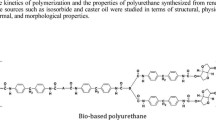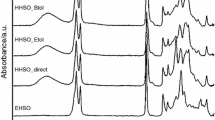Abstract
Polyols synthesized by ozonolysis and hydrogenation from canola oil were reacted with aliphatic 1,6-hexamethylene diisocyanates (HDI) to produce polyurethane (PU) elastomers. The properties of the materials were examined by dynamic mechanical analysis (DMA), thermomechanical analysis (TMA), modulated differential scanning calorimetry (MDSC), and thermogravimetric analysis (TGA), and measurements were taken of tensile properties. The effect of dangling chains on network properties was assessed. The formation of hydrogen bonds was observed by FTIR. The measured properties were found to be strongly dependent on processing-dependent factors such as the crosslinking density and the molar ratio of polyols to HDI component. The glass transition temperatures (T g) of the elastomers were found to increase as the OH/NCO molar ratio decreased. With the same OH/NCO molar ratio, T g of canola-oil-based PU was higher than that of soybean-oil-based PU. The TGA thermographs showed two well-defined steps of degradation for all the elastomers. In the first step, up to 30% weight loss, the fastest rate of loss was found at 345 °C for canola-oil-based PU while soybean-oil-based PU lost most of the weight in the second step. With the same OH/NCO molar ratio, the elastomers made from canola-oil-based polyol showed slightly higher Young’s modulus and tensile strength.








Similar content being viewed by others
References
Sperling LH, Manson JA (1983) Interpenetrating polymer networks from triglyceride oils containing special functional groups—a brief review. J Am Oil Chem Soc 60:1887–1892
Sperling HL, Manson JA, Linne MA (1984) Simultaneous interpenetrating networks prepared from special functional group triglyceride oils: castor oil, Lesquerella palmeri and other wild plant oils. J Polym Mater 1:54–67
Pryde EH, Princen LH, Mukherjee KD (eds) (1981) New sources of fats and oils (American Oil Chemists Society Monograph no. 9). American Oil Chemists Society, Champaign, IL
Nayak PL (2000) Natural oil-based polymers: opportunities and challenges. J Macromol Sci Rev Macromol Chem Phys C 40:1–21
Barrett LW, Sperling LH, Murphy CJ (1993) Naturally functionalized triglyceride oils in interpenetrating polymer networks. J Am Oil Chem Soc 70: 523–534
Carlson KD, Chang SP (1985) Chemical epoxidation of a natural unsaturated epoxy seed oil from Vernonia galamensis and a look at epoxy oil markets. J Am Oil Chem Soc 62:934–939
Khoe TH, Otey FH, Frankel EN (1972) Rigid urethane foams from hydroxymethylated linseed oil and polyol esters. J Am Oil Chem Soc 49:615–618
Hu YH, Gao Y, Wang DN, Hu CP, Zu S, Vanoverloop L, Randall D (2002) Rigid polyurethane foam prepared from a rape seed oil based polyol. J Appl Polym Sci 84:591–597
Dwan’Isa LJP, Mohanty AK, Misra M, Drzal LT, Kazemizadeh M (2003) Novel biobased polyurethanes synthesized from soybean phosphate ester polyols: thermomechanical properties evaluations. J Polym Environ 11:161–168
Guo A, Demydov D, Zhang W, Petrovic ZS (2002) Polyols and polyurethanes from hydroformylation of soybean oil. J Polym Environ 10:49–52
Zlatanic A, Petrovic ZS (2002) Viscoelastic properties of polyurethanes based on model triglycerides. Abstr Pap Am Chem Soc 223:D77–D77
Petrovic ZS, Zhang W, Javni I (2005) Structure and properties of polyurethanes prepared from triglyceride polyols by ozonolysis. Biomacromolecules 6:713–719
Elfman-Borjesson I, Harrod M (1997) Analysis of non-polar lipids by HPLC on a diol column. J High Res Chromatog 20:516–518
Neff WE, Mounts TL, Rinsch WM, Konishi H, Elagaimy MA (1994) Oxidative stability of purified canola oil triacylglycerols with altered fatty-acid compositions as affected by triacylglycerol composition and structure. J Am Oil Chem Soc 71:1101–1109
Yu TL, Lin TL, Tsai YM, Liu WJ (1999) Morphology of polyurethanes with triol monomer crosslinked on hard segments. J Polym Sci Pol Phys 37:2673–2681
Coleman MM, Lee KH, Skrovanek DJ, Painter PC (1986) Hydrogen bonding in polymers: 4. Infrared temperature studies of a simple polyurethane. Macromolecules 19:2149–2157
Hepburn C (1982) Polyurethane elastomers. Applied Science, London
McKenna GS (1989) In: Booth C, Price C (eds) Comprehensive polymer science: the synthesis, characterization, reactions, and applications of polymers. Vol 2: Polymer properties. Pergamon, Oxford, pp 311–362
Eisenberg A (1993) Physical properties of polymers. American Chemical Society, Washington, DC, pp 61–96
Hutchinson JM (1998) Characterising the glass transition and relaxation kinetics by conventional and temperature-modulated differential scanning calorimetry. Thermochim Acta 324:165–174
Hutchinson JM (2003) Studying the glass transition by DSC and TMDSC. J Therm Anal Calorim 72:619–629
Wunderlich B (2004) The tribulations and successes on the road from DSC to TMDSC in the 20th century and the prospects for the 21st century. J Therm Anal Calorim 78:7–31
Khandare PM, Zondlo JW, Pavlovic AS (1996) The measurement of the glass transition temperature of mesophase pitches using a thermomechanical device. Carbon 34: 663–669
Williams RJ (1994) Methods for determination of glass transitions in seeds. Ann Bot 74:525–530
Czech P, Okrasa L, Boiteux G, Mechin F, Ulanski J (2005) Polyurethane networks based on hyperbranched polyesters: synthesis and molecular relaxations. J Non-Cryst Solids 351:2735–2741
Nielsen LE, Landel RF (1994) Mechanical properties of polymers and composites, 2nd edn. Marcel Dekker, New York, Ch 4
Flory PJ (1953) Principles of polymer chemistry. Cornell University Press, Ithaca, NY
Ferry JD (1980) Viscoelastic properties of polymers. Wiley, New York, Ch 11
Petrovic ZS, Zhang W, Zlatanic A, Lava CC, Ilavsky M (2002) Effect of OH/NCO molar ratio on properties of soy-based polyurethane networks. J Polym Environ 10:5–12
Petrovic ZS, Zavargo Z, Flynn JH, Macknight WJ (1994) Thermal degradation of segmented polyurethanes. J Appl Polym Sci 51:1087–1095
Javni I, Petrovic ZS, Guo A, Fuller R (2000) Thermal stability of polyurethanes based on vegetable oils. J Appl Polym Sci 77:1723–1734
Acknowledgements
The authors acknowledge the technical contributions of Mr. Ereddad Kharraz. The financial support of NSERC, Bunge Corp., AVAC Ltd. and Archer Daniels Midland are gratefully acknowledged.
Author information
Authors and Affiliations
Corresponding author
About this article
Cite this article
Narine, S.S., Kong, X., Bouzidi, L. et al. Physical Properties of Polyurethanes Produced from Polyols from Seed Oils: I. Elastomers. J Amer Oil Chem Soc 84, 55–63 (2007). https://doi.org/10.1007/s11746-006-1006-4
Received:
Accepted:
Published:
Issue Date:
DOI: https://doi.org/10.1007/s11746-006-1006-4




